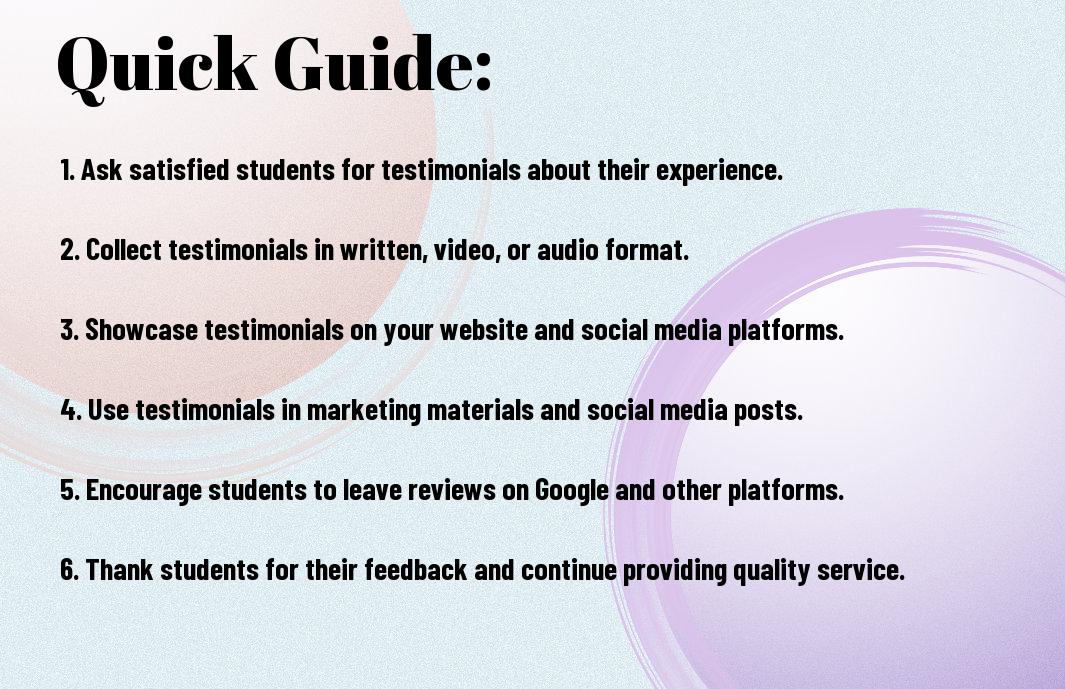Just like in any business, student testimonials can be a powerful tool for your language school. They provide social proof of the quality of your courses and can help attract new students. However, knowing how to effectively gather and utilize these testimonials is key to harnessing their full potential.
By implementing strategies such as offering incentives, making it easy for students to leave reviews, and showcasing testimonials on your website and social media platforms, you can build credibility and trust with potential new students. Additionally, learning how to ask for reviews in a way that elicits detailed and honest feedback can help you gather testimonials that are not only glowing but also authentic.
In this guide, we will investigate into the importance of student testimonials for your language school, strategies for collecting them, and creative ways to make the most out of them. By following these tips, you can leverage the power of student testimonials to attract more students and grow your language school.
Key Takeaways:
- Build trust: Student testimonials can help build trust with potential students by showcasing the positive experiences of others.
- Showcase results: Use testimonials to highlight the results and improvements that students have achieved through your language school.
- Use on marketing materials: Incorporate student testimonials on your website, social media, and other marketing materials to attract new students.
- Ask for permission: Always ask for permission from students before using their testimonials to ensure privacy and consent.
- Diversity: Aim to collect testimonials from a diverse group of students to showcase different perspectives and experiences.
- Encourage honesty: Encourage students to provide honest and detailed testimonials so that potential students can get a genuine sense of the school.
- Continuous feedback: Regularly collect new testimonials to keep your marketing materials up to date and relevant.


Types of Student Testimonials
Little is more powerful than the words of satisfied students when it comes to promoting your language school. Different types of testimonials can provide a well-rounded view of the student experience, helping to build trust and credibility with potential customers. Here are some common types of student testimonials you can collect to showcase the value of your language school:
- Written Testimonials
- Video Testimonials
- Audio Testimonials
- Online Reviews and Ratings
Knowing how to effectively leverage these different types of testimonials can greatly benefit your language school’s marketing efforts. For more tips on this topic, check out this Best Tips for Leveraging Student Testimonials with Top … article.
Written Testimonials
There’s no denying the power of written testimonials in influencing potential students. By displaying quotes from satisfied students on your website or marketing materials, you can provide social proof of the quality of your language courses. Encourage students to share detailed accounts of their experiences, highlighting positive aspects such as improved language skills, supportive teachers, and a welcoming learning environment.
In addition to traditional text-based testimonials, consider incorporating video testimonials into your marketing strategy. Video testimonials allow potential students to see and hear directly from current students, adding a personal touch to their feedback. Success with video testimonials lies in capturing genuine emotions and experiences, so be sure to let students speak freely about their time at your language school. Another benefit of video testimonials is that they can be easily shared on social media platforms to reach a wider audience.
Audio Testimonials
Interviews with students can provide valuable insights into the impact of your language courses. By conducting audio testimonials, you can capture the tone and inflection of students’ voices, adding an extra layer of authenticity to their feedback. These testimonials can be shared on your website or podcast to reach a broader audience. Testimonials shared in an audio format can create a sense of connection between potential students and your language school, making it easier for them to envision themselves as part of your community.
Online reviews and ratings on platforms like Google, Yelp, or Facebook can also play a significant role in shaping public perception of your language school. Documentary-style reviews that detail students’ experiences in depth can provide valuable insights for potential customers. The positive reviews can build trust and credibility, while negative reviews can offer opportunities for improvement and showcase your commitment to addressing concerns.
The key to effective testimonial collection and utilization lies in diversifying the types of testimonials you gather to paint a comprehensive picture of the student experience at your language school. By incorporating written, video, audio testimonials, and online reviews, you can create a compelling narrative that resonates with potential students and sets your language school apart from the competition.
Tips for Gathering Powerful Testimonials
Your language school can benefit greatly from collecting student testimonials that showcase the positive experiences and outcomes of your programs. To gather powerful testimonials, consider the following tips:
Identifying Your Testimonial Goals
Some of your testimonial goals may include building credibility, attracting new students, and highlighting the success stories of your current students. Before reaching out for testimonials, determine what specific objectives you want to achieve with the feedback. Whether it’s promoting a particular course or demonstrating the overall quality of your language school, having clear goals will help you gather testimonials that effectively support your marketing efforts.
When requesting testimonials, provide students with guidance on the aspects of their experience you would like them to address. Encourage them to share specific examples of how your language school has helped them improve their skills or achieve their language learning goals. The more focused the testimonials are, the more impactful they will be in resonating with your target audience.
Managing the Timing of Requests
Tips for effectively timing your testimonial requests include reaching out to students shortly after they have completed a course or achieved a significant milestone in their language learning journey. Consider sending personalized emails or messages to express your appreciation for their feedback. This personal touch can increase the likelihood of students providing detailed and meaningful testimonials that can be used to promote your language school.
Crafting Effective Questions for Testimonials
When crafting questions for testimonials, focus on prompting students to share their experiences in a structured and compelling way. Ask open-ended questions that encourage detailed responses and showcase the value your language school has provided. Consider asking students about their favorite aspects of the program, the skills they have developed, and how their experience has impacted their language learning journey.
Managing the responses to your questions can help ensure that you receive testimonials that align with your goals. Provide students with examples of well-crafted testimonials to guide them in formulating their responses. Offer assistance in refining their feedback to highlight the most impactful aspects of their experience at your language school.
Setting the Scene for Authentic Responses
If you want to elicit authentic responses from students, create a comfortable and non-judgmental environment for them to share their feedback. Emphasize the importance of honesty and transparency in their testimonials. Encourage students to express their opinions openly and provide constructive criticism if they feel it will help improve the overall experience for future students.
Effective responses from students can serve as valuable insights for your language school’s continuous improvement efforts. By fostering a culture of open communication and genuine feedback, you can cultivate a community of students who are willing to share their positive experiences and recommendations with others.
Legal and Ethical Considerations
Considerations for legal and ethical practices when collecting and sharing student testimonials include obtaining consent from students to use their feedback for promotional purposes. Ensure that students understand how their testimonials will be used and provide them with the option to remain anonymous if they prefer. Respect their privacy and ensure that their testimonials are presented accurately and ethically to maintain trust with your audience.
Responses that adhere to legal and ethical guidelines can help your language school build a positive reputation and establish credibility with potential students. By upholding transparent practices and valuing the privacy and rights of your students, you can leverage testimonials as powerful marketing tools that attract new students and showcase the value of your language programs.

Step-by-Step Guide to Obtaining Testimonials
| Step 1: Planning Your Approach | Step 2: Selecting the Right Candidates |
Step 1: Planning Your Approach
Any successful testimonial gathering process starts with a well-thought-out plan. Begin by identifying the goal of collecting student testimonials. Determine where and how you will use them to maximize their impact. Consider the best timing for reaching out to students and the most effective methods for gathering their feedback. Whether it’s through surveys, interviews, or written submissions, make sure your approach aligns with your objectives.
Next, create a timeline for the testimonial collection process. Decide how many testimonials you need and set a deadline for obtaining them. Map out who will be responsible for reaching out to students and following up on their responses. Establish a system for organizing and storing the testimonials once they are collected to ensure easy access and use in the future.
Lastly, outline the criteria for selecting the testimonials that will best represent your language school. Consider factors such as diversity, authenticity, and relevance to different target audiences. Be prepared to adapt your approach as needed based on the feedback received and any unexpected challenges that may arise during the testimonial gathering process.
Step 2: Selecting the Right Candidates
Little is a crucial step in obtaining valuable testimonials is selecting the right candidates to provide feedback. Identify students who have had a positive and meaningful experience at your language school. Look for individuals who can speak eloquently about their journey, progress, and overall satisfaction with the programs and services offered. Consider reaching out to students from different backgrounds and proficiency levels to showcase a diverse range of perspectives.
When identifying candidates, prioritize authenticity and genuine enthusiasm in their testimonials. Encourage students to share specific examples of how your language school has helped them achieve their goals and overcome challenges. By selecting candidates who can provide detailed and heartfelt testimonials, you can create a more compelling and impactful narrative that resonates with potential students and stakeholders.
Step 2: Selecting the Right CandidatesAny successful testimonial gathering process starts with a well-thought-out plan. Begin by identifying the goal of collecting student testimonials. Determine where and how you will use them to maximize their impact. Consider the best timing for reaching out to students and the most effective methods for gathering their feedback. Whether it’s through surveys, interviews, or written submissions, make sure your approach aligns with your objectives.
Step 3: Setting Up the Process
Setting up a streamlined and efficient process for collecting testimonials is necessary to ensure a smooth and effective experience for both students and language school staff. Create clear guidelines and instructions for students on how to submit their testimonials, whether through an online form, email, or in-person interview. Provide support and resources to assist students in articulating their thoughts and experiences accurately.
Establish a communication plan to keep students informed about the testimonial collection process and any updates or deadlines. Regularly follow up with students who have agreed to provide testimonials to offer guidance, answer questions, and address any concerns they may have. Implement a feedback loop to gather insights on ways to improve the testimonial gathering process for future campaigns.
Moreover, ensure that the privacy and confidentiality of students are respected throughout the testimonial collection process. Obtain written consent from students to use their testimonials for promotional purposes and clarify any usage rights or restrictions. By setting up a transparent and secure process, you can build trust with students and maintain the integrity of their feedback.
Step 3: Setting Up the ProcessSetting up a streamlined and efficient process for collecting testimonials is necessary to ensure a smooth and effective experience for both students and language school staff. Create clear guidelines and instructions for students on how to submit their testimonials, whether through an online form, email, or in-person interview. Provide support and resources to assist students in articulating their thoughts and experiences accurately.
Step 4: Conducting the Interviews
Even after selecting the right candidates, conducting interviews with students is a critical step in obtaining detailed and insightful testimonials. Schedule one-on-one interviews with selected students to research deeper into their experiences at the language school. Prepare a set of open-ended questions that encourage students to share their personal stories, achievements, and challenges.
During the interviews, actively listen to students’ responses and ask follow-up questions to gather more detailed information. Create a comfortable and welcoming environment that allows students to express themselves freely and openly. Record the interviews or take detailed notes to capture the essence of students’ testimonials accurately.
After completing the interviews, express gratitude to the students for sharing their experiences and feedback. Provide them with an opportunity to review and revise their testimonials if needed before finalizing them for publication. By conducting interviews thoughtfully and respectfully, you can create compelling and authentic testimonials that resonate with your audience.
Step 4: Conducting the InterviewsEven after selecting the right candidates, conducting interviews with students is a critical step in obtaining detailed and insightful testimonials. Schedule one-on-one interviews with selected students to research deeper into their experiences at the language school. Prepare a set of open-ended questions that encourage students to share their personal stories, achievements, and challenges.
Step 5: Editing and Finalizing the Testimonials
Testimonials collected from students may need some editing and refinement to ensure clarity, coherence, and relevance. Review each testimonial carefully to correct any grammar or spelling errors, improve readability, and enhance the overall impact of the message. Consider condensing lengthy testimonials to highlight the most compelling and relevant points while preserving the authenticity of students’ voices.
Collaborate with students to incorporate any revisions or additional information they wish to include in their testimonials. Seek their approval on the final version before publishing or sharing them publicly. Design visually appealing layouts to showcase the testimonials on your language school’s website, social media channels, or promotional materials effectively.
Another aspect to consider is the use of multimedia elements such as photos, videos, or audio recordings to enhance the testimonials. Visual and audio testimonials can create a more engaging and dynamic experience for viewers, further reinforcing the credibility and impact of the testimonials. By editing and finalizing the testimonials thoughtfully, you can create a powerful and compelling narrative that highlights the strengths and unique value of your language school.
Step 5: Editing and Finalizing the TestimonialsTestimonials collected from students may need some editing and refinement to ensure clarity, coherence, and relevance. Review each testimonial carefully to correct any grammar or spelling errors, improve readability, and enhance the overall impact of the message. Consider condensing lengthy testimonials to highlight the most compelling and relevant points while preserving the authenticity of students’ voices.
Factors to Consider When Using Testimonials
After successfully collecting student testimonials for your language school, there are several critical factors to consider when utilizing them effectively. Testimonials can be a powerful tool to attract potential students and build credibility for your institution. However, it’s imperative to strategize how to present these testimonials thoughtfully to maximize their impact.
Relevance to Prospective Students
Consider the demographics of your target audience and select testimonials that resonate with their specific needs and aspirations. Highlight testimonials that showcase the diverse experiences of your students, including different language proficiency levels, cultural backgrounds, and learning objectives. Personalize the information by featuring testimonials from students who have achieved similar goals or overcome challenges that resonate with prospective students. Perceiving testimonials as a direct reflection of what potential students can expect from your language school will help establish trust and credibility.
Cultural Sensitivity
To ensure cultural sensitivity, carefully review the language and content of the testimonials. Consider the cultural backgrounds and perspectives of both the students providing testimonials and the prospective students who will read them. The testimonials should reflect a welcoming environment. The tone and language used should be respectful.
Balancing Quantity and Quality
Even though having a large number of testimonials can be beneficial, it’s crucial to prioritize quality over quantity. Quantity alone does not guarantee credibility or effectiveness. Select testimonials that are detailed, specific, and highlight the key strengths of your language school. Avoid repetitive or generic testimonials that do not add value or provide meaningful insights. By balancing the number of testimonials with their quality, you can create a more compelling and persuasive narrative that resonates with prospective students.
When choosing testimonials, focus on authenticity and relevance. Highlighting a few high-quality testimonials that showcase the unique selling points of your language school can have a more significant impact than an extensive collection of mediocre testimonials. This strategic approach will help you establish a strong reputation and attract students who are genuinely interested in the educational experience your institution offers.
Updating Your Testimonials Regularly
Clearly, testimonials should not be static but should evolve with the changing needs and expectations of your prospective students. Regularly updating your testimonials ensures that they remain relevant, fresh, and reflective of the current student experiences at your language school. Consider periodically reaching out to your alumni or current students for updated testimonials that reflect the latest programs, initiatives, or achievements of your institution. By keeping your testimonials up-to-date, you demonstrate to prospective students that you are committed to continuous improvement and excellence.
Quality testimonials that reflect the current state of your language school can help build credibility and trust among prospective students. When potential students see recent testimonials that speak to the relevance and impact of your programs, they are more likely to consider enrolling in your institution. By regularly updating your testimonials, you can maintain a competitive edge in the ever-evolving landscape of language education.
Measuring the Effectiveness of Testimonials
Prospective students rely on testimonials to make informed decisions about their educational journey. Therefore, it’s imperative to track and measure the impact of your testimonials on student enrollment and satisfaction. This data will provide valuable insights into which testimonials are the most effective in attracting students and building credibility for your language school. By analyzing the performance of your testimonials, you can make data-driven decisions to optimize your marketing strategies and enhance the overall student experience.
This ongoing evaluation process allows you to identify trends, preferences, and areas for improvement in your testimonial collection and presentation. By measuring the effectiveness of your testimonials, you can continuously refine your approach and tailor your messaging to better meet the needs and expectations of prospective students. Utilizing metrics to assess the impact of testimonials will help you stay competitive in the market and adapt to the ever-changing landscape of language education.
Pros and Cons of Different Testimonial Formats
Many language school owners understand the importance of student testimonials in showcasing the quality of their programs. However, choosing the right format for testimonials can be a crucial decision. Each format – written, video, audio, and online reviews – has its own set of pros and cons that can impact the effectiveness of the testimonial in attracting new students. In this chapter, we will explore the advantages and disadvantages of each format to help you make an informed decision for your language school.
Pros and Cons of Written Testimonials
Clearly, written testimonials are a popular choice for many language schools due to their ease of collection and sharing. They can be easily displayed on your website, brochures, or social media platforms, providing potential students with valuable insights from past students. However, written testimonials lack the personal touch that other formats, such as video testimonials, can provide. Additionally, there is always a concern about the authenticity of written testimonials, as they can be easily fabricated or manipulated.
| Pros | Cons |
|---|---|
| Easy to collect and share | Lack personal touch |
| Can be displayed on multiple platforms | Authenticity concerns |
Pros and Cons of Video Testimonials
Formats such as video testimonials can offer a more engaging and authentic experience for potential students. The visual and auditory elements can convey emotions and sincerity in a way that written testimonials cannot. However, creating high-quality video testimonials may require more resources and technical expertise. Additionally, some students may feel camera-shy or uncomfortable sharing their experiences on video, limiting the number of testimonials you can collect in this format.
| Pros | Cons |
|---|---|
| Engaging and authentic | Resource-intensive |
| Conveys emotions effectively | Camera-shyness of some students |
Pros and Cons of Audio Testimonials
Consistently, audio testimonials offer a middle ground between written and video testimonials. They allow for the personal touch of hearing a student’s voice while still being easier to create than video testimonials. However, audio testimonials lack the visual appeal that video testimonials provide, and they may not be as attention-grabbing as video content. Additionally, some potential students may prefer written testimonials for easier readability and convenience.
| Pros | Cons |
|---|---|
| Personal touch with voice | Lack visual appeal |
| Easier to create than video testimonials | May not be as attention-grabbing |
Pros and Cons of Online Reviews
Plus, online reviews are an increasingly important source of testimonials for language schools, as they provide social proof and can reach a wider audience. Positive online reviews can significantly boost your school’s reputation and credibility. However, online reviews are also vulnerable to fake or malicious reviews, which can harm your school’s reputation. Managing online reviews and responding to feedback promptly can be a time-consuming task for language school owners.
| Pros | Cons |
|---|---|
| Wide reach and social proof | Vulnerable to fake reviews |
| Boost reputation and credibility | Time-consuming to manage |
The choice of testimonial format for your language school should align with your marketing goals, target audience, and resources. By understanding the pros and cons of different testimonial formats, you can make an informed decision that will best showcase the quality and impact of your language programs.
Integrating Testimonials into Your Marketing Strategy
Website Integration
One effective way to leverage student testimonials for your language school is by integrating them into your website. Testimonials provide social proof of the quality of your school and can help build trust with potential students. You can create a dedicated section on your website specifically for testimonials, or strategically place them throughout your site to highlight different aspects of your school.
For instance, you can feature positive testimonials on your homepage to immediately capture the attention of visitors. You can also include testimonials on specific course pages to showcase the success stories of students who have taken those courses. Including photos and names of the students alongside their testimonials can add an extra layer of authenticity.
Moreover, make sure to regularly update your testimonials to keep your website content fresh and relevant. Encourage happy students to leave reviews and testimonials, and consider offering incentives such as discounts or freebies to motivate them.
Social Media Utilization
Marketing your language school on social media platforms is a powerful way to reach a wider audience, and integrating student testimonials into your social media strategy can further amplify your marketing efforts. Share testimonials as posts on your social media accounts, and consider creating visually appealing graphics or videos to make them stand out.
One key advantage of using testimonials on social media is that they can be easily shared and liked by your followers, increasing the visibility of your school. Encourage students to share their testimonials on their own social media profiles to reach an even larger audience and attract more potential students.
Utilize hashtags related to language learning and education to increase the reach of your testimonials on social media platforms such as Instagram and Twitter. Engage with comments and feedback on your testimonials to show that you value the input of your students and followers.
Print and Digital Brochures
Integration of testimonials into your print and digital brochures can further enhance your marketing materials and make a compelling case for potential students to choose your language school. Including testimonials in your brochures adds a personal touch and helps prospective students visualize themselves succeeding in your programs.
Feature strong testimonials prominently in your brochures, highlighting specific achievements or improvements that students have experienced as a result of attending your school. Consider using photos or video testimonials in digital brochures to make them more engaging and impactful.
Ensure that your brochures are easily shareable either in print format at events or digitally through email or social media. Including a call-to-action with each testimonial can prompt readers to take the next steps towards enrolling in your courses.
Email Marketing Campaigns
Leveraging student testimonials in your email marketing campaigns can help increase the open and click-through rates of your emails. Include testimonials in your email newsletters to showcase the success stories of your students and encourage recipients to learn more about your language programs.
On top of that, consider segmenting your email list based on different target audiences and including testimonials that are most relevant to each group. Personalize your emails by addressing recipients by their names and including testimonials that resonate with their specific language learning goals.
For instance, you can feature testimonials from students who have achieved fluency in a specific language or have successfully passed language proficiency exams. Including a compelling subject line that highlights the testimonials can grab the attention of recipients and increase the chances of them engaging with your email content.
Encouraging Student Participation and Incentivization
Despite the benefits of student testimonials for language schools, getting students to provide feedback can sometimes be challenging. To overcome this obstacle, it is crucial to create a culture of active participation and engagement among students. One effective way to do this is by encouraging students to share their experiences through testimonials. For more guidance on how to utilize student testimonials effectively, check out this article on How to Use Student Testimonials to Boost Enrollment.
How to Encourage Students to Provide Testimonials
Provide students with clear guidelines on how to write a testimonial and make the process as easy as possible for them. Offer prompts or questions to guide their feedback and remind them of the impact their testimonials can have on potential students.
Engage with students personally and build relationships that make them feel valued and willing to share their thoughts. Consider hosting feedback sessions or events where students can express their experiences in a supportive environment.
Highlight the benefits of providing testimonials, such as helping future students make informed decisions and contributing to the improvement of the language school. Recognize and appreciate students who participate by showcasing their testimonials prominently.
The Role of Incentives in Obtaining Testimonials
To encourage more students to provide testimonials, offering incentives can be a powerful motivator. Consider rewards such as discounts on future courses, exclusive access to events, or personalized certificates of appreciation.
By providing incentives, students are more likely to take the time to share their feedback and experiences. However, it is important to strike a balance between incentivizing participation and maintaining the authenticity and sincerity of the testimonials.
Another important aspect to consider when using incentives is to ensure that they align with the values and culture of the language school. Incentives should enhance the student experience and reinforce the school’s commitment to excellence, rather than overshadowing the genuine feedback provided.
Maintaining Authenticity While Offering Rewards
Little actions like sending a personalized thank you note or featuring student testimonials in newsletters and social media can go a long way in showing appreciation for their feedback. These gestures help maintain authenticity and reinforce the value of student testimonials.
Authenticity is crucial in using student testimonials to promote a language school. It is crucial to uphold the integrity of the feedback while still offering rewards to incentivize student participation. By striking a balance between authenticity and incentivization, language schools can effectively leverage student testimonials to enhance their reputation and attract more students.
Responding to Negative Feedback and Improving Your Language School
Addressing Negative Testimonials Constructively
All businesses, including language schools, are bound to receive negative feedback at some point. There’s no need to panic when this happens. Instead, view negative testimonials as an opportunity for improvement. When addressing negative feedback, it’s vital to remain calm and professional. Take the time to understand the customer’s perspective, acknowledge their concerns, and offer a sincere apology for any shortcomings. It is crucial to show empathy and demonstrate a willingness to make things right for the dissatisfied customer. By taking a constructive approach to negative testimonials, you can turn a potentially damaging situation into a chance to enhance your language school’s reputation.
Using Negative Feedback to Implement Changes
Assuming a growth mindset is crucial when it comes to using negative feedback to implement changes in your language school. Negative testimonials can provide valuable insights into areas that need improvement. Analyze the feedback you receive and look for common themes or issues that arise repeatedly. Use this information to identify areas where your language school can grow and evolve. Implementing changes based on negative feedback demonstrates a commitment to excellence and a willingness to listen to the needs of your students. By consistently striving to address and rectify any shortcomings, you can create a more positive and fulfilling experience for your students.
Language schools should view negative feedback as an opportunity to refine their offerings and enhance the overall learning experience for students. By continuously seeking feedback and making improvements based on that feedback, language schools can stay relevant and competitive in a crowded market. Embracing a culture of continuous improvement will not only benefit your students but also help your language school thrive in the long run.
The Importance of a Response Strategy
Responding promptly and effectively to negative feedback is crucial for maintaining the reputation of your language school. A well-thought-out response strategy can help you address negative testimonials in a timely manner and show your commitment to customer satisfaction. When crafting responses to negative feedback, be sure to address the customer’s concerns directly, offer a sincere apology, and present a solution to rectify the situation. By handling negative feedback professionally and transparently, you can build trust with your students and showcase your dedication to their success.
Feedback is an invaluable tool for language schools looking to improve their services and foster a positive learning environment. By responding to negative testimonials constructively, using feedback to drive meaningful changes, and implementing a robust response strategy, language schools can turn negative experiences into opportunities for growth and enhancement. Be mindful of, addressing negative feedback with professionalism and a commitment to improvement is key to building a successful and reputable language school.

What Can Be Learned from Other Language Schools
Assuming the best practices of other language schools can provide valuable insights for improving your own testimonial campaigns. Consider studying the types of testimonials that resonate most with prospective students, the platforms that yield the highest engagement, and the frequency and timing of testimonial posts. By learning from the successes and challenges of other schools, you can refine your approach and create compelling testimonial campaigns that attract and retain students effectively.
The key takeaway from analyzing successful testimonial campaigns is the importance of authenticity, relevance, and strategic promotion. By showcasing real stories of student success and satisfaction, language schools can build credibility and trust with potential students, ultimately driving enrollment and fostering a positive reputation within the industry.
Summing up
The process of getting and using student testimonials for your language school is a crucial aspect of building credibility and trust with potential students. By actively seeking feedback from current and former students, you can showcase the real-life experiences and positive outcomes of your language programs. These testimonials serve as powerful marketing tools that can attract new students and help differentiate your school from competitors.
When collecting testimonials, it is important to make the process as easy and convenient as possible for students. Providing clear guidelines and prompts can help elicit detailed and meaningful responses that highlight the strengths of your language school. Utilizing these testimonials across your marketing channels, such as your website, social media, and promotional materials, can further enhance your school’s reputation and drive enrollment.
Keep in mind, student testimonials are more than just words on a page – they are reflections of the impact your language school has had on students’ lives. By harnessing the power of these testimonials, you can create a compelling narrative that resonates with prospective students and sets your school apart as a trusted and reputable institution in the language learning industry.
FAQ
Q: Why are student testimonials important for a language school?
A: Student testimonials provide social proof of the effectiveness and quality of your language school, helping to build credibility and trust with potential students.
Q: How can I collect student testimonials for my language school?
A: You can collect student testimonials by asking students to write reviews, record video testimonials, or participate in case studies highlighting their experiences at your language school.
Q: What is the best way to request testimonials from students?
A: The best way to request testimonials from students is to ask for feedback at the end of a course or program when their positive experiences are fresh in their minds.
Q: How should I use student testimonials to promote my language school?
A: You can use student testimonials on your website, social media platforms, marketing materials, and in advertising campaigns to showcase the success stories of your students.
Q: How can I ensure the authenticity of student testimonials?
A: To ensure the authenticity of student testimonials, you can ask students to provide their full name, photo, and details about their course and experience at your language school.
Q: Can I use student testimonials without their permission?
A: No, it is important to obtain permission from students before using their testimonials to avoid any legal issues. Make sure to have a signed release form from each student granting you permission to use their testimonial.
Q: How can I leverage student testimonials to attract new students?
A: You can leverage student testimonials by featuring them prominently on your website, creating success stories highlighting student achievements, and sharing them with potential students during open houses or information sessions.



